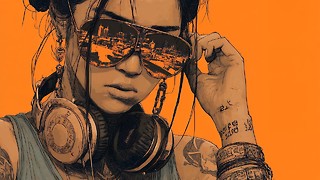Fashion vs. Art
“I’d rather buy a dress and put it up on the wall than put up a painting, wouldn’t you?” Convention says that, unlike Andy Warhol, I can wear a dress without scandal, but I’m with Andy on this one: hours of lusting after unwearable and/or unaffordable clothes, along with thousands of blisters and/or cash-flow problems, testify to a fine and painful line between fashion and art.
Warhol’s own illustrious career as an artist began with commercial fashion illustrations. His rainbow-coloured, blotted-ink drawings of shoes (yes, the blistering kind) are now snapped up at less-than-commercial prices, stalking out of the auction room in the hands of art collectors.
And the shoe fetish doesn’t end there: French photographer Guy Bourdin constantly pushed the boundary between art and fashion. His advertising campaign for Charles Jourdan shoes created iconic, shocking images – the detached lower legs of a mannequin dressed in Jourdan footwear strut in front of a black cab in a deserted street. In these commercial images, Bourdin strove to shift focus away from product and model towards a more eclectic vision.
Peeking somewhat sheepishly from the other side of the supposed divide, fashion has constantly reflected and revisited art as inspiration: in the last month both Vogue and The Guardian (arguably representing a true gamut of fashion reporting) have run features focused on ‘high art’.
Surrealist-inspired surroundings gave the traditional Vogue shoot a certain extra something, especially for those of us who like a little culture with our fashion cravings. In The Guardian, John Paul Pietrus recreated iconic paintings with Coleen McLoughlin as his model. Unlike Vogue’s recourse to art to sell new-look clothes, the Pietrus shots instead aim to recreate a range of famous portraits. From John Singer Sargent’s ‘Madame X’ to Manet’s ‘Bar at the Folies-Bergères’, the focus is on fashion-as-tasteful-art (and Coleen as, well, tasteful).
Both shoots do, however, have a common aim: to sell clothes. Beautiful clothes can only be seen by a limited number of eager eyes. Beautiful photographs of said clothes on the other hand can reach millions. Mario Testino has been instrumental in bringing more than one recent fashion trend into the spotlight. Giselle’s seemingly-unattainable ‘golden-goddess’ look became common visual fare thanks to his well-timed, stunningly composed images. It is his composition and eye for colour, in fact, that keeps Testino firmly in the ‘art’ camp despite huge commercial success.
His first advertising campaign, at Gucci in 1996 heralded a huge leap in the company’s sales. From $500 million to $880 million in under a year is significantly more than Manet or Sargent ever made. Four years later, the National Portrait Gallery (home to over 50 of Sargent’s paintings) saw fit to curate a Testino retrospective which attracted more visitors than any other show in the museum’s history – just short of 170,000.
Hoping to build on an obviously successful formula, the Gallery is currently home to the ‘Face of Fashion’ exhibition. The work of world-renowned fashion photographers being hung in a world-famous art institution would suggest that the blurring of the fashion/art dichotomy benefits art as well as Gucci.
Jenny Kenyon
‘Face of Fashion’ is at the National Portrait Gallery, St. Martin’s Place, London, until May 28th.
 News / Meta opens £12 million lab in Cambridge 11 July 2025
News / Meta opens £12 million lab in Cambridge 11 July 2025 Lifestyle / Reflections on rowing10 July 2025
Lifestyle / Reflections on rowing10 July 2025 News / Write for Varsity this Michaelmas13 July 2025
News / Write for Varsity this Michaelmas13 July 2025 Features / How to catch a coat thief13 July 2025
Features / How to catch a coat thief13 July 2025 Comment / What is originality, anyway? 14 July 2025
Comment / What is originality, anyway? 14 July 2025








